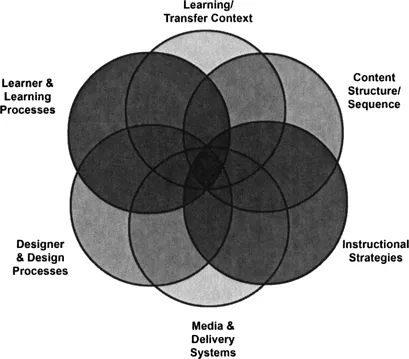![]()
An Overview
of Design and
Development Research
This book is about how to plan and conduct design and development research. These methods are also known as developmental or development research (Richey, Klein, & Nelson, 2004; Seels & Richey, 1994; van den Akker, 1999). Design and development research seeks to create knowledge grounded in data systematically derived from practice. We define this type of research as:
the systematic study of design, development and evaluation processes with the aim of establishing an empirical basis for the creation of instructional and non-instructional products and tools and new or enhanced models that govern their development.
This is a pragmatic type of research that offers a way to test theory and to validate practice that has been perpetuated essentially through unchallenged tradition. In addition, it is a way to establish new procedures, techniques, and tools based upon a methodical analysis of specific cases.
The design and development of instructional products and programs is considered by many to be the heart of the instructional design and technology (IDT) field. Practitioners in the field typically follow well-established systematic models and procedures to design and develop instructional and non-instructional interventions. These approaches are advocated (and have been used) in a wide range of education and training environments. They include a set of common characteristics, including a focus on measurable goals and outcomes derived through an initial analysis phase, the selection of content and strategies that match these goals, a process of routinely evaluating the products prior to finalizing the project, and the assessment of the learning and performance outcomes (Gustafson & Branch, 2002; Seels & Glasgow, 1998).1
The practice of design and development is to a great extent empirical by nature. Design models parallel the scientific problem-solving processes. It would not be unreasonable, then, to assume that design and development processes themselves would have robust empirical support. However, historically there has been a paucity of research on our models, tools, and products.
THE NEED FOR DESIGN
AND DEVELOPMENT RESEARCH
Over the last five decades, many scholars have called for research to strengthen the fundamental knowledge base of the IDT field. In 1953, Finn asserted that the audio-visual field suffered from a dominance of “gadgeteering” that reflected a “poverty of thought” (p. 13) and suggested that research would help professionalize the field. A decade later, Markle (1967) called for the development of empirically grounded instructional materials through systematic testing procedures. In 1984, Heinich stressed the importance of field-based research to inform practice. More recently, Richey (1997) suggested that “our practice is not sufficiently informed by research and that our research is not sufficiently attuned to practice” (p. 91).
Design and Development as a Science
Opinions on the role of research on design and development often depend on one’s conception of what it actually is. We take the position that design and development is a science. As a science it should be bound by understandings built upon replicated empirical research. Our models and procedures should be validated. The solutions to our problems should be supported by data. This, however, is not a universally accepted position.
Davies (1981) first presented the question of whether this field was an art, a craft or a science, opting for the artistic orientation. He viewed design and development as a holistic process, one that cannot be simply analyzed and dissected. It is a view that emphasizes the systemic over the systematic.
Others have also explored the essential nature of the field. For example, Visscher-Voerman and Gustafson’s (2004) study of practicing instructional designers shows that some designers follow an instrumental design paradigm that is rooted in the natural sciences. This approach is akin to the traditional instructional systems design model (ISD). Others employ an artistic paradigm. This approach is one that eschews scientific methods and “dissolves the borders between the domains of the sciences and the arts” (p. 83).
Clark and Estes (1998) view many of the solutions to educational problems as craft. They define craft as skills that are based upon “fortunate accidents, personal experience, insights… revised through trial and error” (p. 6). As an alternative, they advocate following a technology orientation in which problems are addressed through the use of scientific theory.
Like Clark and Estes, we approach design and development (and, in turn, research on it) with the assumption that science and empiricism provide a more effective and reliable route to disciplinary integrity than depending on artistic tactics and craft-based solutions. We believe that our field has not sufficiently employed scientific methods to facilitate our understanding of design and development processes. The need for research is especially critical with respect to the models and processes employed by designers and developers. Few models, design strategies, and tools employed in practice have been empirically tested and validated. This is the gap that design and development research seeks to address.
The Design and Development Knowledge Base and Its Foundations
The field, of course, is not devoid of research. A large and comprehensive base of knowledge informs our work. From our perspective, the design and development knowledge base has six major components. These six facets focus on the different elements of the design and development enterprise: (a) learners and how they learn, (b) the context in which learning and performance occur, (c) the nature of content and how it is sequenced, (d) the instructional strategies and activities employed, (e) the media and delivery systems used, and lastly, (f) the designers themselves and the processes they use. Figure 1-1 portrays the overlapping elements of this knowledge base.
This knowledge base has been shaped over the years by a combination of the foundational research and theory of other disciplines as well as the research and theory unique to instructional design and development. There are three key lines of research and theory that have had the most influence on the design and development knowledge base. These are
• Psychological and learning theory and research.
• Instructional theory and teaching-learning research.
• Communication theory and message design research.
FIGURE 1-1. The IDD knowledge base.
Psychological and learning theory and research provides the dominant foundations for knowledge and practice pertaining to: (a) the learner and the learning process, (b) the learning and transfer context, and (c) instructional strategies. Instructional design (ID) is intimately tied to human learning and today is being extended to organizational learning. Originally, behavioral explanations of the learning process were dominant in instructional design. While there is still some evidence of behavioral thinking, cognitive principles are often followed when devising strategies that facilitate motivation for learning, as well as the understanding, retention, and use of learned information. And today, there is a great deal of interest in the view that “(1) learning is an active process of constructing rather than acquiring knowledge and (2) instruction is a process of supporting that construction rather than communication of knowledge” (Duffy & Cunningham, 1996, p. 171). In this orientation emphasis is placed upon the social context of learning, collaboration, and learner control.
Next, instructional theory and teaching-learning research provides the foundations for knowledge and practice pertaining to (a) content structure and sequence, (b) instructional strategies, and (c) media and delivery systems. While instructional theory is necessarily prescriptive in nature, it is typically in-tertwined with the orientation of a particular learning theory.
Most strategies for presenting instruction are rooted in instructional theory (Reigeluth, 1983; Richey, 1986). One example of a theory of instruction is Gagne’s (1985) Events of Instruction. This theory suggests a particular sequence of instructional activities that can be incorporated into a lesson to facilitate learning and transfer. Constructivist orientations to learning, which avoid the “presentation” of content in favor of students controlling their own learning activities, also rely upon instructional theories and teaching-learning research.
The vast majority of design and development approaches assume that instruction should vary depending upon the type of learning task being addressed. Another important design decision, the selection of media and delivery systems, is typically guided by instructional principles, such as those relating to facilitating learner involvement in “real-world” activities. Currently, the growing use of distance education methodologies is stimulating teaching-learning research in this area, and this work should be of increasing importance to designers and developers.
Lastly, communications theory and message design research has provided the major foundations for knowledge and practice pertaining to media and delivery systems. When combined with the principles of information processing and perception, communication theory tenets and message-design principles guide page layout, screen design, graphics, and visual design. Research relevant to gaining and controlling attention has been of particular importance to the design and development field.
Traditionally, this type of research and theory has been crucial to all media design. Today, its major impact is on the development of interactive, computer-based media and Web design. In all cases, however, this type of research is fundamental to the study and applications of visual thinking, visual learning, and visual communication.
While psychological research, teaching-learning research and message-de...

